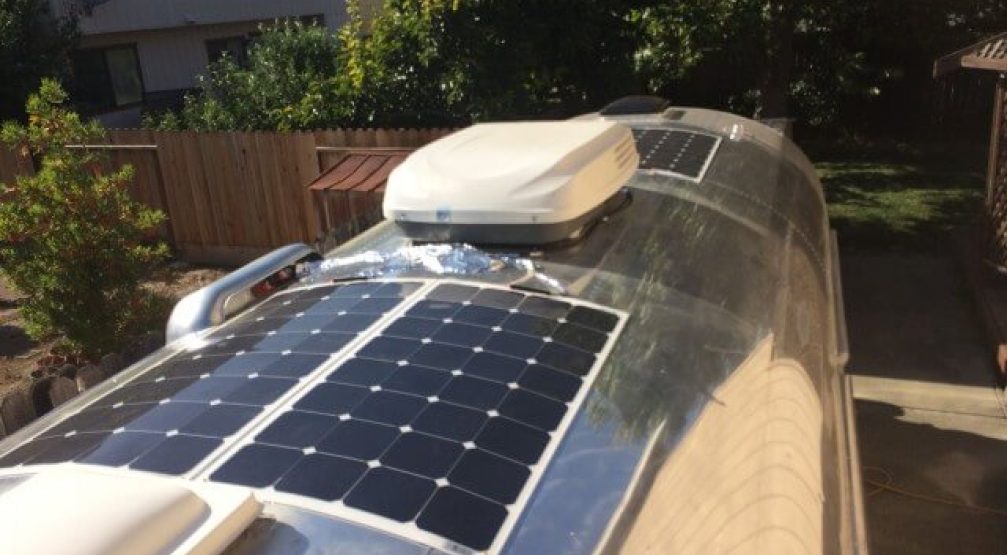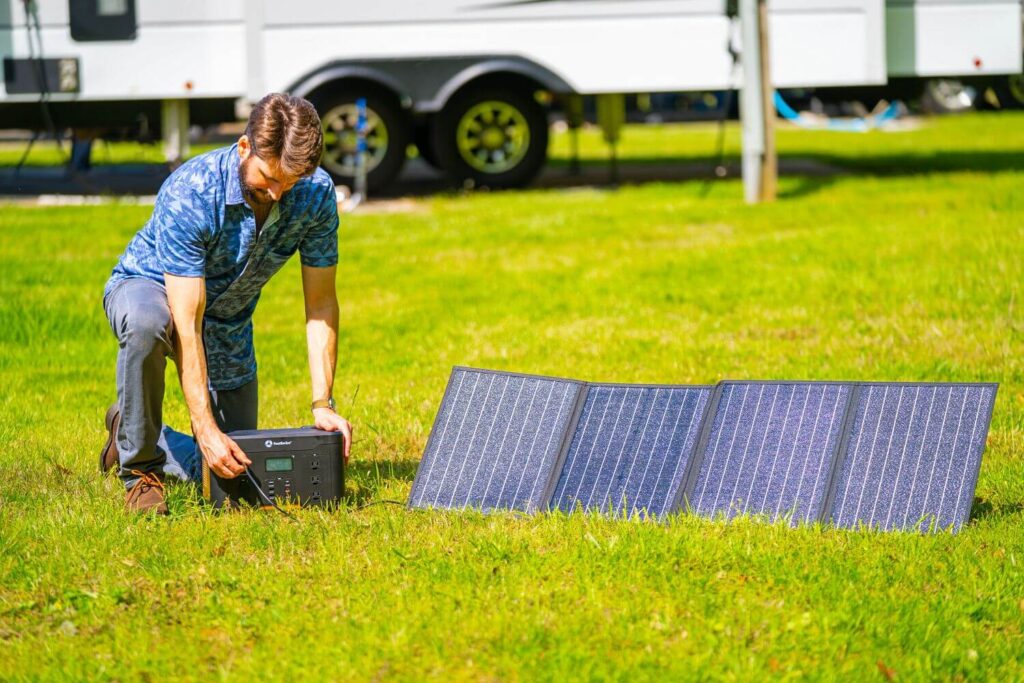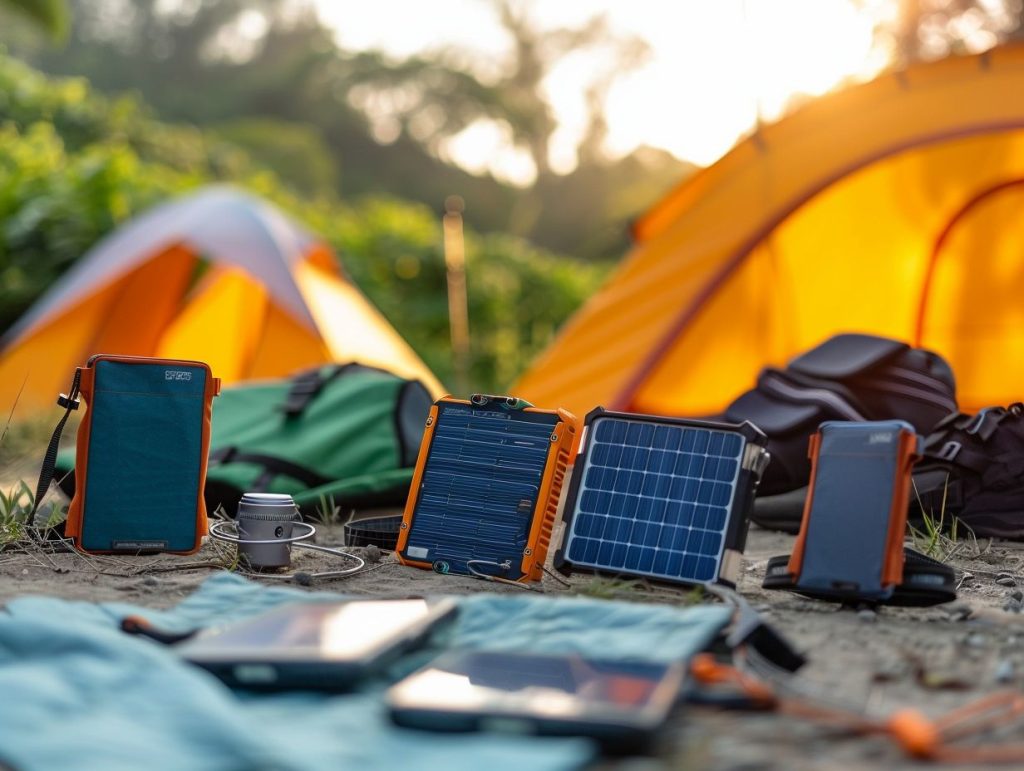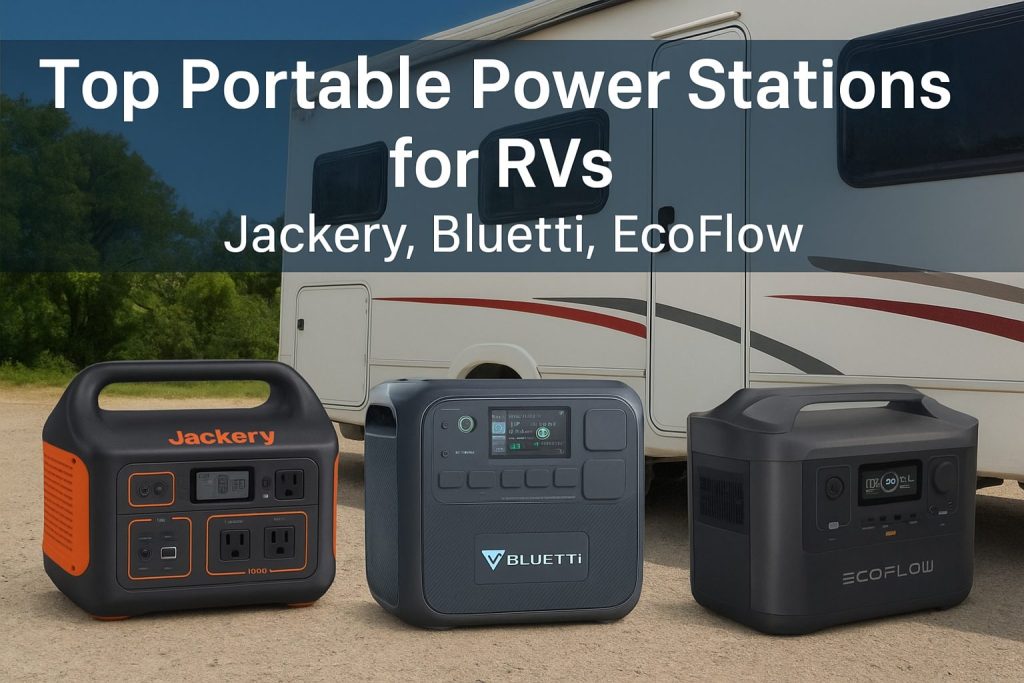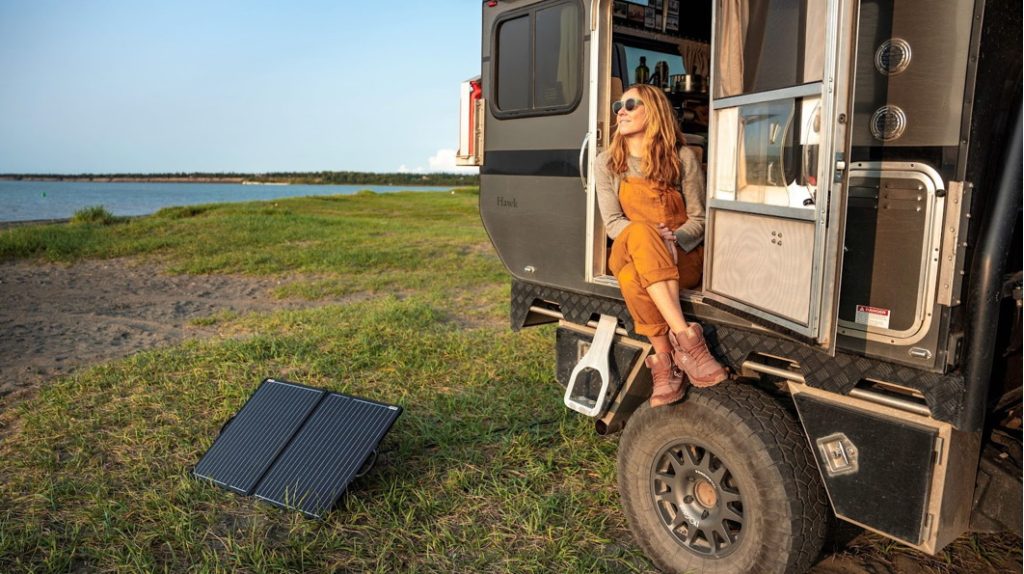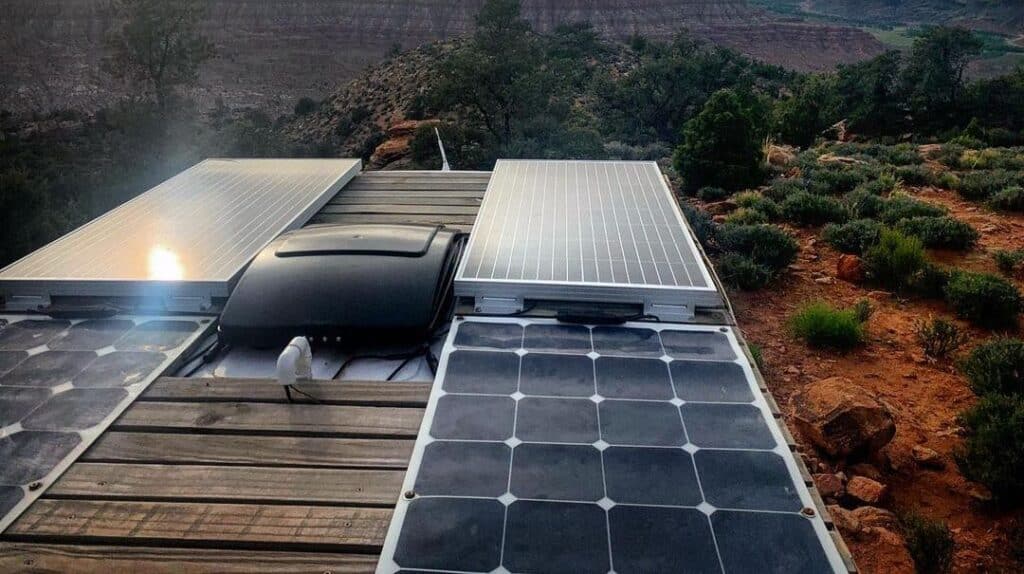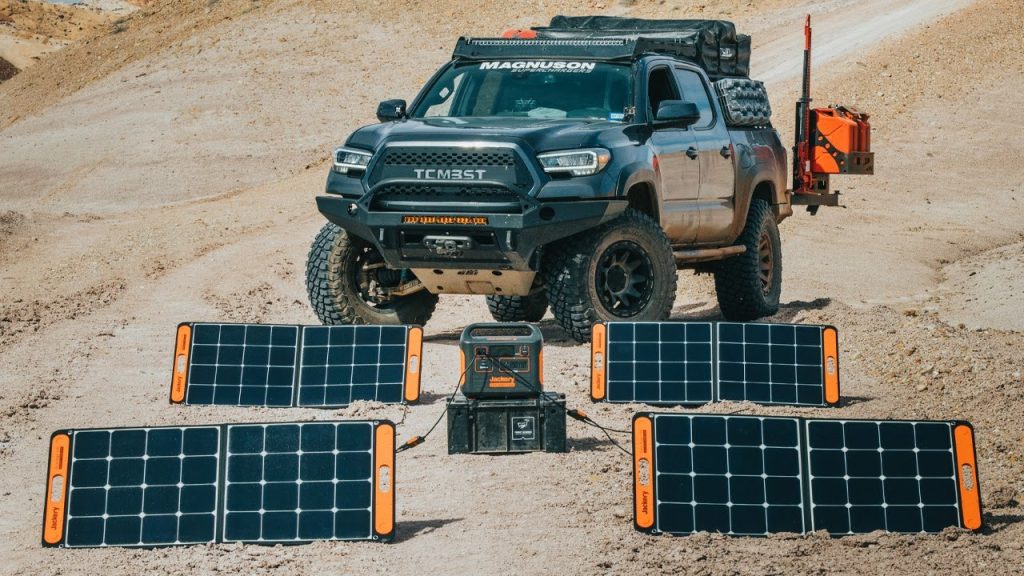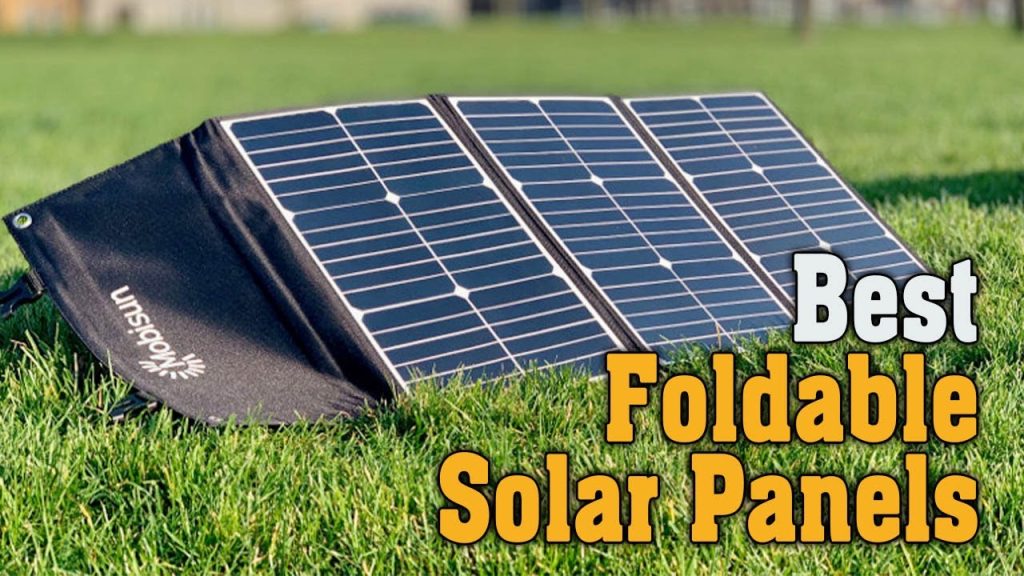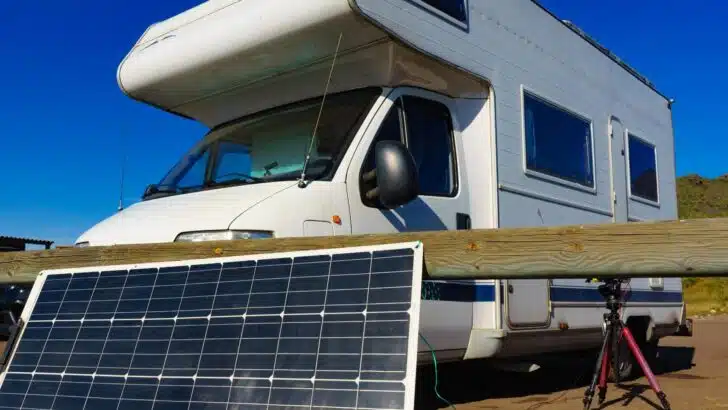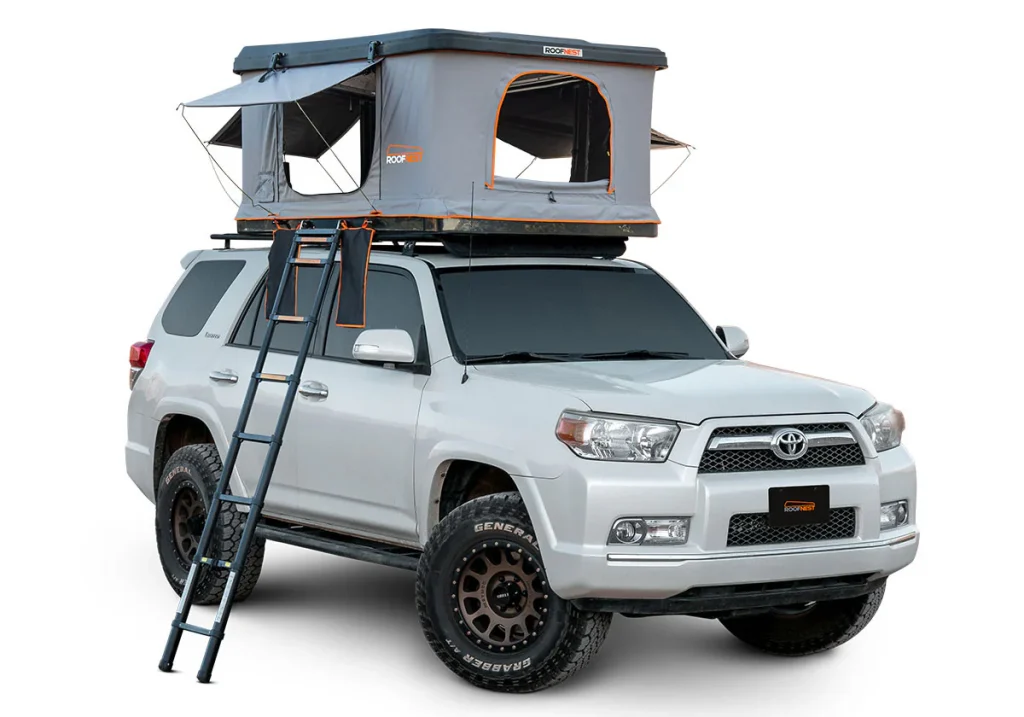The van is parked on a cliffside at golden hour, surfboard propped against the back door, and the only thing between you and a full day of power is a slim strip of roof. For many van converters, that scenario is familiar: limited roof real estate, a desire for stealth and low weight, and the need to squeeze the maximum usable watts into a curved surface. That’s why the best flexible solar panels for vans have become such a popular choice — they conform to bowed roofs, cut wind drag, and weigh far less than framed panels while still delivering solid charge rates.
Flexible panels aren’t a one-size-fits-all solution, though. Quality, watt density, lamination type, and mounting method all decide whether a panel will last the seasons or delaminate after a summer of heat and road vibration. This guide walks you through what matters when choosing flexible panels for a van conversion: how to size your system, what technical specs to prioritize (Voc/Vmp, cell type, top-sheet material), and practical installation and maintenance tips. You’ll also get focused, real-world reviews of five top flexible panels—Renogy 100W Flexible, DOKIO 100W (9BB, ETFE), BougeRV Arch 200W Fiberglass, XINPUGUANG 200W, and Sanraifu 200W—so you can match a product to your roof, load, and budget. Read on for a clear, actionable path from “how much power do I need?” to “which panel should I buy?”
Quick TL;DR — Top picks at a glance
-
Renogy 100W Flexible — Best overall (balanced). Reliable brand, good accessory ecosystem and solid for small/expandable systems. Best for: dependable, easy-to-source 100W builds.
-
DOKIO 100W (9BB, ETFE) — Best lightweight / slim. Ultra-thin ETFE surface and 9-busbar design for durability and light transmission. Best for: ultra-lightweight or stealth installs.
-
BougeRV Arch 200W Fiberglass — Best high wattage single panel. Higher single-panel output and fiberglass lamination for improved durability. Best for: limited roof real estate where you need maximum watts per panel.
-
XINPUGUANG 200W — Best value / high-flex option. Competitive price with high flex claims — verify seller and warranty. Best for: budget builders needing extreme flex.
-
Sanraifu 200W — Best ultra-flexible high-watt. Claimed 270° flex with good watt density; check warranty and seller support. Best for: curved roofs that need a single high-watt flexible module.
Why Choose Flexible Solar Panels for a Van Conversion?
Flexible solar panels have become a game-changer for van conversions, bringing lightweight convenience and sleek design to mobile power systems. Unlike traditional rigid panels that require metal mounting racks and extra roof clearance, flexible panels adhere directly to the surface of your van’s roof. Their low profile means reduced wind drag, better aerodynamics, and a cleaner look—ideal for stealth campers who want to stay off the radar in urban areas.
Another key advantage is weight savings. Flexible panels typically weigh 70–80% less than their framed counterparts, making them perfect for small vans and high-roof conversions where every pound affects fuel efficiency and handling. They also conform easily to curved or uneven roofs, letting you make the most of limited space on campervans, Sprinters, or even smaller vehicles. Installation is simpler too—many panels mount with adhesive tape or sealant, cutting down on drilling and potential leaks.
Of course, there are trade-offs. Flexible panels often have lower long-term durability due to thinner construction and increased heat exposure on metal roofs. Over time, adhesion or lamination layers can degrade, especially under intense sun. They may also show slightly lower peak efficiency per cell area compared to rigid glass panels.
Still, their benefits shine in specific use cases: minimalist van builds, seasonal road trips, and stealth camping setups where discretion and portability matter most. For those exploring their first van conversion electrical system, flexible panels offer a lightweight, accessible starting point without complex mounting hardware.
How to Pick the Right Flexible Panel for Your Van (Buyer’s Guide)
Choosing the right flexible solar panel involves balancing power needs, budget, and roof design. Below is a step-by-step guide to help you select the most efficient setup for your van.
Wattage & System Sizing
The first step is estimating how much energy your van uses daily. List every device—lights, fridge, fans, laptops, and chargers—and total their watt-hour (Wh) consumption.
Example:
-
LED lights: 40W × 4 hrs = 160Wh
-
12V fridge: 45W × 8 hrs = 360Wh
-
Laptop + phone charging: 100W × 2 hrs = 200Wh
Total = ~720Wh/day
To replace that energy daily, you’d need around 150–200W of solar under good sunlight conditions (assuming 4–5 effective sun hours). For full-time van life, many choose 300–400W systems paired with a 100Ah–200Ah lithium battery bank.
Voltage, Voc, and Charge Controller Compatibility
Every panel lists its Voc (open-circuit voltage) and Vmp (voltage at maximum power). These numbers must match your charge controller’s input range. For example, a 12V system with an MPPT controller can safely handle 18–22V panels, while higher-voltage panels may need series/parallel configuration adjustments. Always check that your controller’s maximum PV input voltage exceeds the total Voc of your array.
Cell Type, Busbars, and Lamination
-
Monocrystalline vs. Polycrystalline: Monocrystalline cells (used in most modern flexible panels) are more efficient and compact—ideal for vans.
-
Busbars (9BB/10BB): More busbars reduce resistance, improving durability and output consistency, especially under shading or vibration.
-
Lamination type:
-
ETFE → Best-in-class durability and light transmission.
-
PET → Cheaper but less UV resistant.
-
Fiberglass composite → Excellent heat resistance and longevity.
-
Panels like the BougeRV Arch 200W Fiberglass combine ETFE and fiberglass layers for superior toughness—great for long-term van life.
Flex Rating & Mounting Limitations
Flex rating determines how much a panel can safely bend without damaging cells. For instance, “flex up to 240°” means it can adapt to a gentle curve, not a tight fold. Always avoid bending below manufacturer specs, and reinforce edges with sealant or mechanical fasteners to prevent lifting at highway speeds.
Durability, Warranty & IP Ratings
Durability depends on materials and sealing. Look for IP67 or IP68-rated junction boxes that resist rain and dust. Over time, adhesive edges can loosen—especially on aluminum roofs that expand with heat. Panels from reputable brands often include 1–5 year material warranties, which reflect quality assurance.
Weight, Size & Roof Real Estate
Before purchasing, measure your roof’s usable space and note any vents, fans, or racks.
-
Single 200W panel: Simplifies wiring but may be heavier and less flexible.
-
Two 100W panels: Easier to fit between roof fixtures and provide modular scalability.
If stealth is a priority, thinner 100W panels like DOKIO 100W (9BB, ETFE) blend seamlessly with the van’s profile.
Price & Seller Support
The cheapest flexible panels often come from unverified brands with inconsistent warranties. Since flexible panels can fail early if improperly sealed, buy from established sellers with return policies and verified reviews. Reliable support ensures replacement options if lamination, delamination, or output loss occurs within warranty.
✅ Quick Checklist:
-
Calculate your daily Wh usage
-
Check MPPT/PWM voltage compatibility
-
Choose monocrystalline + ETFE or fiberglass
-
Verify flex specs (°) and IP rating
-
Compare size/weight to roof space
-
Buy from reputable sellers with solid support
In-Depth Reviews — The 5 Recommended Flexible Solar Panels for Vans
Below are five of the best flexible solar panels for vans in 2025, chosen for their balance of efficiency, durability, and installation versatility. Each review includes detailed specs, pros and cons, and notes on who each model best suits.
#1 Renogy 100W Flexible Solar Panel (12V) – Lightweight & Reliable Off-Grid Solution

The Renogy 100W Flexible Solar Panel is a top choice among vanlifers and overlanders who need a lightweight, low-profile solar option. With up to 240° flexibility, it easily conforms to curved surfaces such as RV roofs, boats, or vans. Despite its thin 0.08″ design, it offers durable performance with IP68 protection, Grade A monocrystalline cells, and pre-attached MC4 connectors for seamless installation. Ideal for modular setups or stealth builds where space and aerodynamics matter most.
- Power Output: 100W (12V system)
- Cell Type: Monocrystalline (Grade A)
- Flexibility: Up to 240° curvature
- Connectors: MC4-compatible, pre-attached cables
- Dimensions: ~47″ × 21.3″ × 0.08″
- Weight: ~4.2 lbs
- Proven brand reputation and support
- Durable, reliable output for flexible installs
- Seamless compatibility with Renogy ecosystem
- Ideal for modular solar setups (2–4 panels)
- Lightweight and easy to mount with adhesives or screws
- Slightly pricier than generic 100W panels
- Moderate flexibility vs newer fiberglass models
#2 DOKIO 100W Flexible Solar Panel (9BB ETFE)

The DOKIO 100W flexible panel is a standout lightweight option for van owners who need stealth, portability, and simplicity. Its ETFE top layer enhances light transmission and surface strength while preventing yellowing over time—an upgrade over cheaper PET panels. The 9BB cell design improves current flow and reduces the likelihood of micro-cracks during bending or vibration, crucial for mobile applications like vans or boats. This panel works well for minimalist builds—charging smaller 12V battery banks or serving as a supplement to existing arrays. It’s especially useful for stealth campers who want minimal visual profile without cutting into roof aerodynamics.
- Power Output: 100W (18V nominal)
- Cell Type: Monocrystalline with 9 Busbars (9BB)
- Surface: ETFE anti-scratch, anti-reflective coating
- Flexibility: Up to 30° curvature
- Dimensions: 38.4″ × 22.2″ × 0.04″
- Weight: ~2.3 lbs
- Ultra-light and paper-thin for easy mounting
- ETFE surface increases longevity and performance
- Excellent value for budget-conscious buyers
- 9BB design enhances current efficiency
- Limited flex range (30°) — not ideal for heavily curved roofs
- Warranty and long-term durability vary by seller
#3 BougeRV Arch 200W Fiberglass Flexible Solar Panel

The BougeRV Arch 200W Fiberglass panel is a premium solution for those needing high wattage in limited roof space. Its fiberglass-reinforced construction offers greater heat resistance, rigidity, and protection from impact than PET-based panels. Combined with ETFE coating and 10-busbar monocrystalline cells, it delivers reliable performance even under daily sun exposure on metallic van roofs.
This 200W panel is excellent for vanlifers running energy-hungry devices like 12V fridges, laptops, fans, and lighting simultaneously. A single BougeRV Arch can generate enough power for a modest off-grid setup, reducing the number of panels needed and simplifying wiring.
- Power Output: 200W
- Cell Type: Monocrystalline, 10 Busbars (10BB)
- Surface: ETFE + fiberglass composite lamination
- Flexibility: Up to 270° curvature
- Dimensions: ~58.1″ × 30.0″ × 0.08″
- Weight: ~7 lbs
- Junction Box: IP67 rated
- Higher single-panel wattage = fewer roof panels
- Durable fiberglass backing extends lifespan
- ETFE layer resists scratches and UV degradation
- Strong brand support and positive customer service reputation
- Slightly heavier than 100W flexible panels
- Higher upfront cost
#4 XINPUGUANG 200W Flexible Solar Panel

The XINPUGUANG 200W flexible solar panel is an affordable option for those seeking higher power without adding multiple smaller panels. While the brand is lesser-known, its specifications are appealing—high efficiency, strong flex capability, and lightweight construction. The monocrystalline cells deliver good performance, while optional ETFE versions add resilience against UV and scratches.
Because XINPUGUANG sells through multiple vendors, quality can vary slightly between batches, so it’s best purchased through sellers with high feedback and clear warranty information. When installed properly, these panels can match or even outperform costlier alternatives in real-world tests.
- Power Output: 200W (12V configuration)
- Cell Type: Monocrystalline (claimed 23–24% efficiency)
- Flexibility: Up to 260° curvature
- Surface: ETFE/PET (varies by model)
- Weight: ~4–5 lbs
- Junction Box: IP67 rated
- Excellent price-to-watt ratio
- High flexibility for curved roofs
- Lightweight and easy to install
- Good conversion efficiency (23–24% claims)
- Quality control varies between sellers
- Limited official customer support outside Amazon
#5 Sanraifu 200W Flexible Solar Panel
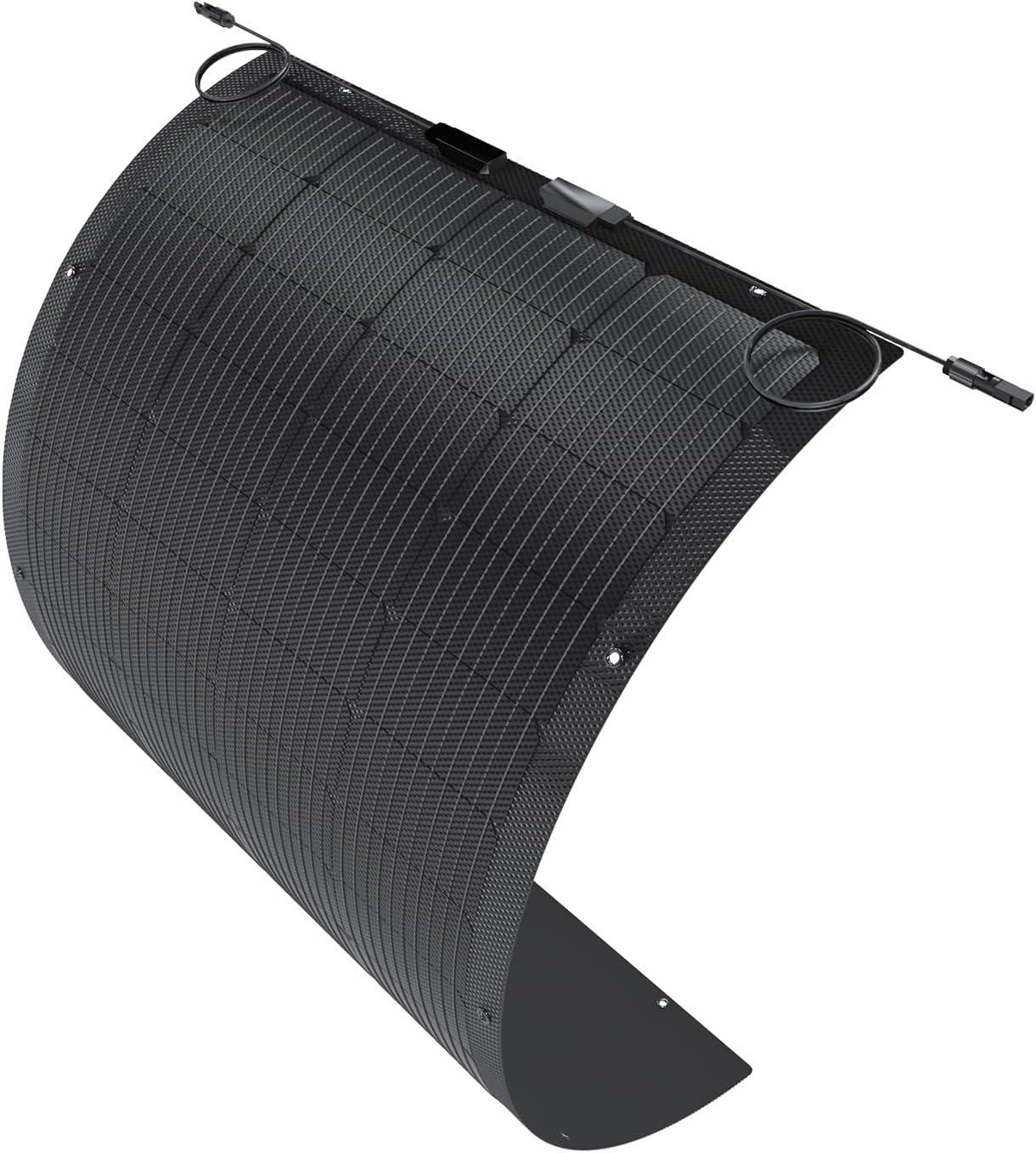
The Sanraifu 200W flexible solar panel caters to van owners who need both high power output and maximum flexibility. Its ETFE surface enhances light absorption and protects against scratches, while its 270° flex rating makes it one of the most adaptable panels in its category. The IP68 junction box is well-sealed, guarding against moisture ingress—important for vehicles traveling in humid or coastal environments.
With proper mounting, the Sanraifu delivers consistent charging for 12V systems and can be wired in series or parallel to support larger MPPT controllers. Its slightly heavier build reflects thicker protective layers, designed to extend service life compared to ultra-thin panels.
- Power Output: 200W
- Cell Type: Monocrystalline
- Surface: ETFE laminate
- Flexibility: Up to 270°
- Dimensions: ~59″ × 28″ × 0.08″
- Weight: ~7.5 lbs
- Junction Box: IP68 waterproof rating
- Excellent flex range for complex roof shapes
- High wattage for compact van builds
- ETFE + IP68 combo for durability
- Strong weather resistance and decent price
- Newer brand with limited long-term data
- Slightly heavier than other flexible models
Side-by-Side Comparison Table + Short Analysis
Below is a quick comparison table summarizing the top five best flexible solar panels for vans in 2025.
| Model | Watt | Vmp / Voc | Cell Type | Top Sheet | Flex Rating | Weight | Dimensions (in) | Estimated Price Range (USD) | Best For |
|---|---|---|---|---|---|---|---|---|---|
| Renogy 100W Flexible | 100W | 19.1V / 22.5V | Monocrystalline | PET / Polymer | ~240° | 4.2 lbs | 47 × 21.3 × 0.08 | $120–$150 | Reliable, small-to-medium systems |
| DOKIO 100W (9BB ETFE) | 100W | 18.0V / 22.0V | Mono (9BB) | ETFE | ~30° | 2.3 lbs | 38.4 × 22.2 × 0.04 | $70–$90 | Lightweight, stealth builds |
| BougeRV Arch 200W Fiberglass | 200W | 20.4V / 24.3V | Mono (10BB) | ETFE + Fiberglass | ~270° | 7 lbs | 58.1 × 30.0 × 0.08 | $270–$320 | High-output single-panel installs |
| XINPUGUANG 200W | 200W | 19.8V / 23.8V | Monocrystalline | ETFE / PET | ~260° | 4.8 lbs | 52 × 21 × 0.08 | $120–$160 | Budget-friendly high-flex setups |
| Sanraifu 200W | 200W | 19.2V / 22.8V | Monocrystalline | ETFE | ~270° | 7.5 lbs | 59 × 28 × 0.08 | $160–$190 | High-flex roofs, coastal/off-road use |
🧭 Short Interpretive Notes
-
For single-day or short trips:
→ DOKIO 100W ETFE is perfect due to its ultra-lightweight and quick mounting, great for portable or removable setups. -
For multi-day off-grid camping:
→ Renogy 100W Flexible (use 2–3 in series/parallel) balances quality, modularity, and reliability for small systems. -
For full-time van-life with higher power needs:
→ BougeRV Arch 200W Fiberglass offers the best single-panel watt density, durability, and fiberglass longevity. -
For tight budgets or high-flex applications:
→ XINPUGUANG 200W provides great watt-per-dollar value—ideal for experimental or budget builds. -
For extreme curves and weatherproof durability:
→ Sanraifu 200W excels with its 270° flex and IP68 rating, suitable for marine-grade or rugged travel setups.
Installation & Mounting Tips for Vans (200–300 words)
Installing flexible solar panels on a van roof requires careful preparation to ensure performance, longevity, and safety. Unlike rigid panels, flexible modules rely primarily on adhesive bonding or hybrid mounting rather than mechanical brackets.
Adhesive vs. Mechanical Mounting
-
Adhesive-only: Use high-bond double-sided tape like 3M VHB 5952 or adhesive sealants such as Sikaflex-252 or Dicor Sealant. This method keeps installs low-profile and aerodynamic.
-
Hybrid approach: Combine adhesive with small stainless screws and washers along edges or use plastic backing plates for additional strength.
-
Avoid over-bending panels—maintain a smooth curve within manufacturer limits (typically 240°–270°).
Roof Preparation
-
Clean thoroughly with isopropyl alcohol.
-
Lightly sand or scuff painted metal for better adhesion.
-
Apply a primer if the adhesive manufacturer recommends it.
-
Test-fit panel placement before applying adhesive.
Wiring & Routing
-
Route MC4 cables through a gland entry box or existing conduit.
-
Use fused connectors or inline fuses close to the battery bank.
-
If combining multiple panels, use an MC4 Y-branch or combiner box with proper fuse protection.
-
Keep wiring neat, protected, and UV-rated.
Ventilation & Heat Considerations
Flexible panels can trap heat—avoid installing over full insulation layers without airflow. Leave small edge gaps or air channels beneath where possible.
Safety Checklist
-
Always install an inline fuse or circuit breaker near the battery.
-
Use an appropriately rated MPPT charge controller.
-
Ground metal components (if required) and double-check polarity before connecting.
Maintenance, Troubleshooting & Lifespan Expectations (150–200 words)
Even the best flexible solar panels for vans require periodic maintenance to stay efficient on the road. Start with monthly visual checks—inspect adhesive edges for peeling, ensure the junction box and cables are securely sealed, and look for any micro-cracks or surface bubbling that could indicate delamination.
If you notice a power drop, begin by cleaning the panel surface using mild soap and a microfiber cloth—dust, salt, or pollen can reduce output by 10–20%. Then, use a multimeter to test the Voc (open-circuit voltage) and Vmp (maximum power voltage). Compare these readings with the manufacturer’s specs; significant drops may signal internal cell degradation or poor electrical connections.
Flexible panels generally last 5–10 years, depending on exposure and material quality (ETFE panels typically last longer than PET). While rigid glass panels can exceed 20 years, flexible ones trade longevity for lightness and adaptability. Consider replacement when output consistently falls below 80% of original rated power or visible delamination appears—especially if relying on solar as your primary power source.
Cost & Value — Realistic Budgeting for a Van Conversion (120–180 words)
Budgeting for solar in a van conversion depends on your power goals and material choices. As of 2025, expect:
-
100W flexible panel: $70–$150
-
200W flexible panel: $120–$300
-
MPPT charge controller (30A–40A): $80–$180
-
Wiring, fuses, MC4 connectors: $40–$80
-
Adhesives, sealant, and entry gland: $20–$50
-
Optional professional installation: $150–$300
Altogether, a reliable 200–400W flexible solar setup costs roughly $300–$800 for DIY installation.
To cut costs without losing reliability, buy panels from reputable brands or verified sellers with clear warranties. Consider a hybrid system—use one framed rigid panel for consistent base power and one flexible panel for curved or stealth areas. Avoid ultra-cheap listings with vague specs or no IP ratings; a small upfront saving can lead to costly replacements later.
Frequently Asked Questions
1. Are flexible panels as efficient as rigid panels?
Not quite. Flexible panels are typically 3–5% less efficient than rigid glass modules due to heat buildup and thinner lamination. However, their lighter weight and ability to mount on curved roofs make them ideal for van installations where aerodynamics and stealth matter most.
2. Can I stick flexible panels to my van roof permanently?
Yes, but proper prep is critical. Clean, sand, and use high-quality adhesives like 3M VHB or Sikaflex-252. Reinforce edges with sealant to prevent lift from wind or heat. Once bonded, removal may damage paint, so plan placement carefully.
3. How many watts do I need for full-time van living?
Full-time van lifers usually need 300–600W of solar, depending on power use (fridge, fan, lights, laptop). Pair your panels with an MPPT charge controller and a lithium battery bank of at least 100–200Ah for consistent off-grid power.
4. What happens if a flexible panel gets a puncture?
Minor punctures can be sealed with clear silicone or UV-stable epoxy, but performance may drop. If internal cells are damaged or water enters, replacement is recommended—especially for panels mounted in exposed, high-humidity areas.
5. Can I install flexible panels myself or hire a pro?
DIY installation is common and straightforward if you’re comfortable with basic wiring. For large systems or dual-voltage setups, hiring a professional installer ensures correct MPPT sizing, fusing, and roof sealing.
6. Are the best flexible solar panels for vans weatherproof?
Yes—top-rated panels like Renogy or BougeRV feature IP67–IP68-rated junction boxes and ETFE coatings for weather resistance. Always confirm the rating before purchasing to avoid premature delamination or corrosion.
7. Do flexible panels overheat on van roofs?
They can, especially on dark metal surfaces. Leave slight edge gaps for airflow, or use thermal spacers beneath larger panels to reduce heat buildup and preserve efficiency.
8. Can I mix flexible and rigid solar panels?
Absolutely. A hybrid setup works well—rigid panels for steady generation and flexible ones for curved or hard-to-reach areas. Just ensure voltage and current ratings are compatible before wiring in parallel or series.
Final Recommendation
For van conversions, flexible solar panels deliver the perfect mix of portability, stealth, and freedom from bulky roof racks. While they may not last as long as rigid panels, modern ETFE and fiberglass designs have greatly improved their durability and real-world efficiency.
If you want the most balanced, proven solution, the Renogy 100W Flexible Solar Panel remains the top pick for reliability and ecosystem support. Those needing higher output should consider the BougeRV Arch 200W Fiberglass, offering excellent watt density for limited roof space.
Budget-conscious or minimalist travelers will love the DOKIO 100W ETFE and XINPUGUANG 200W, while the Sanraifu 200W suits adventurous builds needing extreme flexibility.
Whichever model you choose, prioritize quality adhesives, proper wiring, and regular maintenance. With the right setup, your van can stay powered—silently and sustainably—wherever the road leads. 🌞🚐
Read More: Best Solar Panel Kits for Off-Grid RV Living

